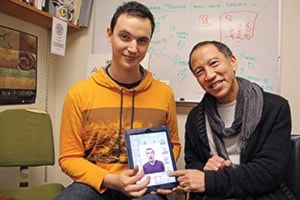A weekend cram session in an Oak Bay house hammered the final nails in seven years of programming for a social tablet app to help children on the autism spectrum.
The scrapbook app Let’s Face It was developed by the University of Victoria’s Centre for Autism Research Technology Education (CARTE).
“Our goal is to develop cutting-edge tools and technology to help children on the autism spectrum and their families in their everyday lives,” said lead James Tanaka, a professor of psychology at UVic. “What we wanted to do is develop an app to work on their face recognition skills.”
The educational games app is a culmination of seven years of UVic work, during which Tanaka garnered input from student volunteers and community members, including high schoolers and those on the autism spectrum.
“We started developing it before the iPad was introduced,” Tanaka said.
While the science is Tanaka’s bailiwick, the programming came down to volunteer time from psychology and computer science students like Jon Bowen. Tanaka also introduced the perfect inspiration for students: food and competition.
“We would have Saturday hack-a-thons,” Bowen said. “We did it for fun and for sushi.”
The two-day culmination, he added, “was fun.”
“The final push, we rented a house in Oak Bay for the weekend and did a 48-hour intensive,” Tanaka said.
The iPad app allows those with Autism Spectrum Disorder to make an interactive album of faces and names. It also has science-based games that train facial recognition through interactive play.
“Our innovative twist is their using faces from their everyday lives,” Tanaka said.
Bowen, a recent UVic grad and software developer on the iPad app, passes the tablet around the table to snap a series of selfies – an activity he and Tanaka are clearly familiar with. Bowen takes a still selfie, then a short video showing his go-to “surprised” face. Tanaka opts for a smile, no smile, smile for his video clip. The still and video clip selfies – a skill most everyone possesses these days Tanaka noted – translate to an album on the tablet. Bowen labels them with corresponding names and begins the Name Game – simply selecting the name that correctly correlates to the face. A second similar game connects the emotions with those displayed on the faces. A third game, Fuse, slices the images in half with the eyes atop and the mouth below, challenging the user to find, for example, the surprised eyes and happy mouth then fusing the image.
Then there’s Splash.
The pinnacle.
They worked hard to employ the same principles that see people spend ample time with games such as CandyCrush and Angry Birds, said Bowen. “We spent a very long time on Splash but it’s by far our most polished.”
It features a series of levels and various games that feature the same photo album but also offer more of the play aspect.
Among the benefits of this app, Tanaka said, is the way the games encourage social interaction, rather than solitary play.
“It’s a social app. It really encourages people to interact and add their faces, and their friends’ faces,” Tanaka said. “I use it to learn the names of students in my class. It has uses beyond those in the autism spectrum.”
Calling on the idea of flash cards, Bowen brings up his album of wild mushroom images each correctly labeled. Students can use it as an effective tool for studying biology, fine arts, psychology and virtually any subject that involves visual images.
“It is a selfie culture and I hope our app will be adopted by anyone who finds it useful,” Tanaka said. “Parents and educators can create their own storybook from people and objects in their children’s lives.”
Let’s Face It is free on iTunes.
